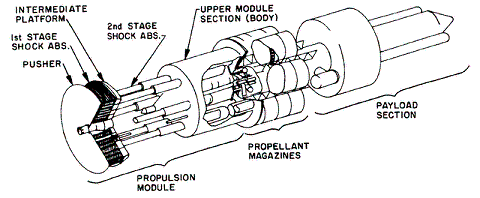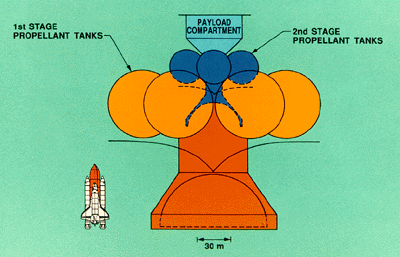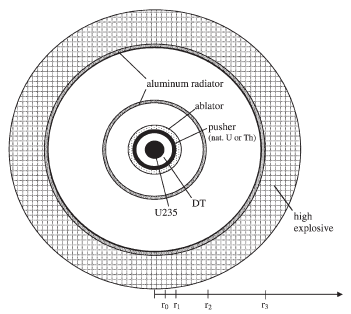Nuclear Pulse Propulsion
Introduction
In contrast to most other forms of propulsion, nuclear pulse propulsion is a feasible proposal based on today’s technology. As its name suggests, the main idea behind this form of drive is to detonate small nuclear pellets close to a spacecraft and have the resulting propellant plasma push the craft forward.
Nuclear pulse propulsion was first mooted in the 1950s in the form of Project Orion. The Orion vehicle was designed to harness the energy released in the process of nuclear fission. Better understanding in the field led to the development of vehicles based on fusion, the latest of which being a combined fission-fusion device.
Fission-based

Configuration of Orion vehicle
The power of the atomic bomb was demonstrated at the close of World War II and scientists wanted to see if this power could be harnessed for more peaceful uses. Project Orion was one of the resulting proposals and its goal was a manned interstellar mission that would take man to Mars and beyond.
The design comprises a pusher plate connected via a series of shock absorbers to propellant magazines and a payload/crew section. The propellant magazines would store nuclear pulse units sufficient for the length of the mission. Each pulse unit would have a nuclear fission device at its core and a propellant layer at one end of the unit. When a pulse unit is ejected through the hole in the pusher plate, the nuclear device at its centre will explode and force high-velocity propellant plasma towards the pusher plate. The acceleration caused by the plasma hitting the plate would be on the order of 50,000 g, which is far too high for a human to withstand. The shock absorbers serve to store the impulse on the pusher plate and transfer the momentum gradually to the payload and crew module. To reduce fission fallout, the Orion vehicle was to have been carried into orbit by a Saturn V or similar lifting rocket.
The maximum specific impulse achievable by such a design would be on the order of 10,000 seconds, which is far larger than that of a conventional chemical rocket. The thrust would be about 40 MN. The lifetime of the pusher plate design is limited by the erosion of the pusher plate by the heat of the nuclear detonation, but coating the pusher plate with a layer of oil has been found to dramatically reduce the ablation. This is due to the oil acting as an insulator against the short burst of heat from the explosion. Designs similar to the Orion vehicle are thus capable of long missions.
The main disadvantage of the Orion design is its inefficiency. Having the nuclear explosion at a distance behind the craft means that a significant proportion of the energy released is lost into space. Also, similar to an atomic bomb, if the critical mass used is large, not all the fissile material will be consumed in the explosion.
Fusion-based

Project Daedalus schematic with present-day space shuttle for comparison
Project Daedalus suggested by the British Interplanetary Society in the 1970s was the first fusion-based pulse propulsion design. The Daedalus craft would have operated on inertial confinement fusion. Pellets of deuterium and helium would be dropped into a combustion chamber one at a time and each would be exploded by high-energy electron beams. This necessitated a much larger onboard ignition apparatus and the Daedalus craft would have indeed been much larger than the Orion design. The picture on the right shows the scale of the Daedalus design.
Due to its size, Daedalus would have to be assembled in orbit. The large protrusion at the bottom of the diagram is the first-stage combustion chamber. A strong magnetic field would be set up in the chamber to confine the explosion and channel the high-velocity plasma out the rear of the craft. By confining the fusion reaction as such, Daedalus would have a higher efficiency than Orion. The specific impulse would have been 1 million seconds and the effective thrust would exceed 700 kN. Daedalus would also have reached a cruising speed of 12% of the speed of light.
Other inertial confinement fusion-based projects have been proposed since Daedalus (e.g. Project Longshot) but most have followed the same general design and hence have similar performance characteristics.
Future of Nuclear Pulse Propulsion

Cross-section of fission-fusion device
In 2005, a form of nuclear pulse propulsion based on mini-fission-fusion devices (mini-nukes) was proposed. These would consist of a fissile core surrounded by a deuterium-tritium (D-T) layer as shown. On ignition, the high explosive would accelerate the aluminium and pusher layers and the D-T layer would heat up sufficiently for fusion to take place. The critical mass of the fission explosive is greatly reduced as neutrons from the fusion reaction will increase the rate of fission.
Because the critical mass of the fissile material can be reduced, the resulting explosion will also be smaller and can be more easily contained in a combustion chamber. This improves efficiency when compared to the Orion design. Using conventional high explosives to start the fusion reaction also allows us to do away with the bulky laser/electron beam apparatus required for inertial confinement fusion, making it possible for a spacecraft to be assembled on Earth and launched into orbit onboard a rocket.
While no designs have been created which employ mini-nukes as their form of propulsion, if practical tests are successful and the system cost is comparable to pure fission or fusion systems, we believe mini-nukes will be the way forward for nuclear pulse propulsion.
Conclusion
Artist's impression of future "Project Orion"
Nuclear pulse drives have much higher specific impulses than chemical rockets and this allows a spacecraft to accelerate extremely quickly and reach their destinations in a much shorter time. However, even though most of the technology required to implement such a drive has been actualised, implementation remains difficult. The stumbling blocks have been mainly political—nuclear test ban treaties make it impossible to carry out practical development and politicians are worried about angering nuclear-weary populations. Also, the lack of a strong mission requirement makes funding for such projects scarce. Despite this, when space agencies begin to plan for manned missions beyond Mars, it is almost certain that they will look hard at this form of propulsion because it makes it possible to travel further, faster.
Bibliography
- Darling, David. Project Daedalus. 21 December, 2009 <http://www.daviddarling.info/encyclopedia/D/Daedalus.html>.
- General Atomic. "Nuclear Pulse Space Vehicle Study: Vol. III - Conceptual Vehicle Designs and Operational Systems." Contracted Study. 1964.
- Long, Kelvin. Icarus: Revisiting the Daedalus Starship. 19 March, 2009. 26 December, 2009 <http://www.centauri-dreams.org/?p=6758>.
- Lucas, Paul. Nuclear Pulse Drives. 2005. 29 December, 2009 <http://www.orbitalvector.com/Deep%20Space%20Propulsion/Nuclear%20Pulse%20Drives/Nuclear%20Pulse%20Drives.htm>.
- Winterberg, F. "Mini-fission-fusion explosive devices (mini-nukes) for nuclear pulse propulsion." Acta Astronautica (2005): 707-712.





